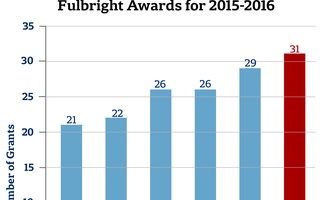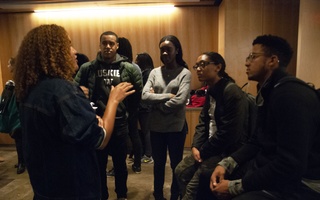{shortcode-48258b3ed51873a58642d58602781999f7d89a42}
The Office of International Education, which facilitates term time, summer, and academic year study abroad for Harvard students, moved from its historic building at 77 Dunster St. to 1414 Mass. Ave. last month, according to Director of OIE Camila L. Nardozzi.
Nardozzi said the move, which was completed Jan. 25, was in large part motivated by the inaccessible nature of the Dunster Street location.
“The administrators' goal is to have student facing offices in fully accessible buildings, and 77 Dunster is not a fully accessible building,” she said.
OIE staff were skeptical at first about the move because they thought the new location at 1414 Mass. Ave might be difficult to find, according to Nardozzi.
“People equate it with Bank of America. Because of that we were concerned students wouldn’t be able to find us,” Nardozzi said. “However, we've still had a ton of appointments, a ton of drop ins, so I think people are still finding us.”
Nardozzi added that OIE staff were “really happy about the results” of the new space..
“I’m happy there’ll be some other folks moving in. It’s nice to be in a space with other folks. They have different traffic than we do. Just having more students around is nice,” Nardozzi said.
77 Dunster St., the former site of the OIE, will still house the Office of Undergraduate Research and Fellowships, which had previously shared the same building with the OIE.
Director of URAF Gregory A. Llacer wrote in an email that URAF “definitely benefited” from the new space because it “had outgrown the upstairs and badly needed more offices.”
“Both floors allows us to have all our counseling and programming staff on the first floor, so we can serve and accommodate all students, including those with mobility challenges,” Llacer said.
Llacer said URAF has also made the space more comfortable.
“We also now have an actual reception and reading area, better and more comfortable waiting space, and a room for our undergraduate research ambassadors to hold peer advising sessions, which we didn’t have before,” Llacer said.
Llacer added that URAF is still looking for ways to further take advantage of its expanded space.
“As we grow into the space we will look for more opportunities to engage students in the building as we do in our residential house during the summer,” Llacer said.
— Staff writer Aspen H. Buck can be reached at aspen.buck@thecrimson.com.
— Staff writer Edward W. Carr can be reached at edward.carr@thecrimson.com.
Read more in College News
It Was A Normal Tuesday Night. Then Scores of Harvard Students Dropped Their Underwear.Recommended Articles
-
 Updated Grant Application Platform Rolled Out
Updated Grant Application Platform Rolled Out -
 Harvard Leads Peer Institutions in Fulbright Awards
Harvard Leads Peer Institutions in Fulbright Awards -
Office Uses Coffee Chats to Encourage Study AbroadSince the beginning of the semester, the Office of International Education has used a new coffee chat program to reach out to students in Harvard’s 12 undergraduate Houses in the hopes of attracting more students to study abroad programs.
-
Kineticism and RestThat’s what makes study abroad special: it’s kinetic, but it gives you time to stand still.
-
 Student Advisers Encourage Students of Color to Study Abroad
Student Advisers Encourage Students of Color to Study Abroad













